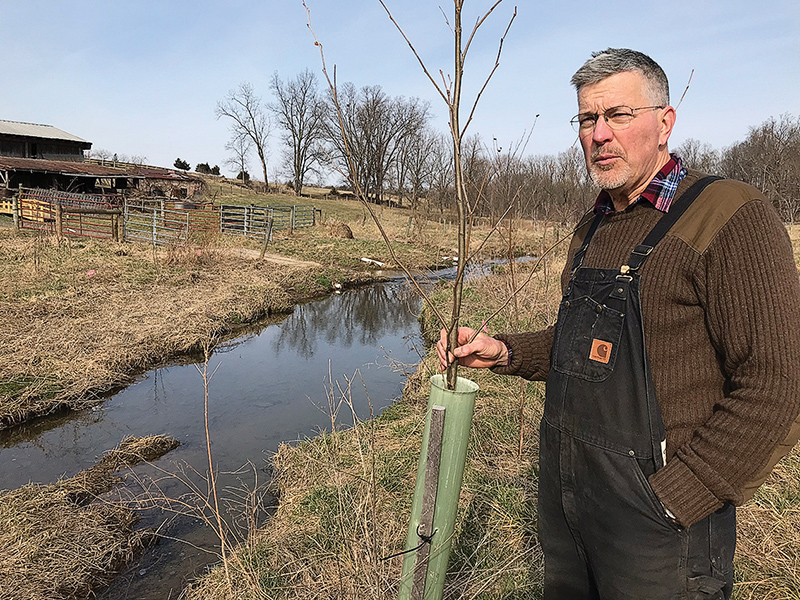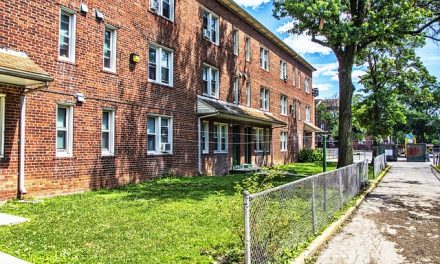We’re happy to report that our friends and partners at the Bay Journal, probably the oldest nonprofit news site in the region, have joined us at the Institute for Nonprofit News. We are grateful to run some of the best environmental coverage in the region and nation. Other local INN members are Baltimore Brew and Maryland Matters.
By Timothy B. Wheeler
Bay Journal
Israel Creek meanders through rolling pastureland on Steve and Ruth Ann Derrenbacher’s farm in Frederick County, MD. A fence keeps their sheep away from the clear, cold water as it flows toward the Monocacy River.
Alder, willow and sycamore saplings in plastic tubes line a portion of the stream. Steve Derrenbacher, a veterinarian and third-generation farmer, said they’d like to add more streamside trees and even permanently preserve the entire 148 acres their family has owned since 1942.
“We intend to pass it on the way we found it — in fact, better than we found it,” Derrenbacher said.
But their conservation hopes are on hold, because the federal program that would pay them to extend the forest buffer is not taking any new applicants right now. Without it, they can’t qualify for a lucrative state conservation easement to preserve the pasture land.
USDA stops new enrollments
The U.S. Department of Agriculture stopped accepting new enrollments last fall in its Conservation Reserve Enhancement Program (CREP), interrupting one of the more attractive ways for farmers in the Chesapeake Bay watershed to voluntarily protect water quality.
It’s not clear when sign-ups will resume. Those working to restore the Bay say the holdup threatens to undermine already lagging efforts to plant forest buffers along streams and rivers in the watershed.
“Any kind of disruption in this is not helpful,” said Craig Highfield, director of forest programs for the nonprofit Alliance for the Chesapeake Bay.
Under CREP, part of a larger USDA Conservation Reserve Program, farmers take cropland or marginal pasture land — typically located along or near water — out of production and plant it with native grasses, trees or other vegetation.
In exchange, they get an annual payment based on the removed acreage, plus incentive and cost-share payments. The plantings serve as buffers that help to reduce erosion, protect water quality and create wildlife habitat.
“It’s a great deal,” said Rob Schnabel, a restoration biologist with the Chesapeake Bay Foundation, who helped the Derrenbachers put in their first riparian buffer. The CREP payments to farmers, provided in a partnership with states and nongovernmental organizations, are among the most generous of any government conservation program.
The USDA’s Farm Service Agency, which administers CREP, suspended enrollments near the end of the last fiscal year on Sept. 30. At that time, according to those who work with the program, the agency said it did so to avoid exceeding a national cap set by the 2014 Farm Bill on the number of acres of land that could participate.
The new Farm Bill passed in December by Congress retains CREP and increases the nationwide acreage cap. But the hold on enrollments has yet to be lifted. Those who work to encourage conservation practices say they’ve heard it may be fall before the process resumes.
Sylvia Rainford, a USDA spokeswoman, said the Farm Service Agency is evaluating unspecified changes to CREP and other conservation programs that may be dictated by the new Farm bill.
“We will work to implement those changes as quickly as possible,” she said. “We also will address resuming CREP acreage enrollment as quickly as we can.”
Major role in creating forest buffers
CREP has played a major role in creating forest buffers in the Bay region.
The federal-state Bay Program has had a goal since 2003 to plant 900 miles of riparian forests annually throughout the six-state watershed.
While there was progress early on, that campaign is lagging badly. Reasons vary — some farmers prefer grassy buffers instead of trees and shrubs, and some shy away from the red tape and oversight involved with taking government money. But another deterrent has been repeated interruptions in CREP, observers say.
CREP was shut down “for a while” about four years ago, recalled Anne Hairston-Strang, associate director of the Maryland Forest Service. And for the last couple of years, she said, there have been “program pauses” to keep from exceeding the nationwide acreage cap.
If the USDA resumes enrollments soon, there shouldn’t be a major interruption in CREP buffer plantings, say some of those working with the program. But some farmers, like the Derrenbachers, were hoping to conduct plantings this spring.
Maryland has been offering one-time payments of $6,000 an acre to acquire conservation easements on cropland and marginal pastureland in Frederick County. To be eligible, 10 percent of the land must be under CREP contracts. That’s why the Derrenbachers want to enroll more acreage in the program.
“We’re not going anywhere,” Derrenbacher said, but he noted that some farmers are already skittish about dealing with the government. “When [CREP] closes down, this is one more reason for landowners to be skeptical about the program.”
Jamie Weaver, a state forester in Carroll County, said there were six or seven landowners he’d been working with who weren’t able to enroll, and one was “very frustrated” because he’d been counting on the CREP payments to help cover farm expenses.
“He was not very happy with us when he found out this contract didn’t go through,” Weaver said.
Some farmers don’t renew
The holdup may aggravate an existing problem for the Bay’s restoration: Some farmers are not renewing their CREP contracts to maintain forested stream buffers.
Under program rules, farmers can typically re-enroll even if their 10– to 15-year contracts have expired — but it isn’t so forgiving for those farmers with forest buffers. If they don’t renew before their contracts expire, they can’t re-enroll.
The USDA spokeswoman didn’t say whether that rule will impact farmers whose contracts expire while the enrollment and re-enrollment process is closed.
There’s already been a decline in the Bay region’s CREP-funded forest buffers, according to Sally Claggett, a U.S. Forest Service program manager in the Bay Program office. Across the six-state watershed, she said, contracts covering 4,374 acres of forest buffers were not renewed in fiscal year 2017, the most recent year for which data are available.
Dropping out of CREP doesn’t mean the trees automatically come down. But once farmers stop getting payments for the buffers, they’re free to do something else with the land.
Contracts covering another 3,500 acres of forest buffers in the Bay watershed are slated to expire on Sept. 30, according to USDA figures. Nearly 2,000 of those acres are in Pennsylvania alone, with 600 in New York, 500 in Virginia, more than 200 in West Virginia and 175 in Maryland. Delaware has none.
If CREP doesn’t come back online soon, advocates warn, the forest buffer effort could lose even more momentum trying to achieve the 2025 Chesapeake restoration goals.
“Every day or week that goes by that we’re just left sitting on our hands, is just opportunity lost for us to be reaching out to these landowners,” said Weaver of the Maryland Forest Service.






Recent Comments